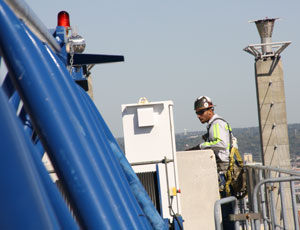Morrow’s QC testing program began about six years ago. Every time a crane comes back from a rental, it gets a top-down inspection. In New York and California, where it is required by law, next comes a round of nondestructive tests: Tower sections are tested using the magnetic particle method, which exposes bad welds or cracks that are unseen to the naked eye. Bolts are tested using the ultrasonic method, which also detects breaks in the material. In other jurisdictions, Morrow tests its bolts every five years, and it tests sections only after structural repairs are made.

Interestingly, Liebherr Group, the Germany-based crane manufacturer that supplies the most equipment to Morrow, only requires a visual inspection of these parts, Juhren says. “Sometimes, you want to go above and beyond,” he adds. Another key risk that Morrow recently identified: electrical shock. Most tower cranes in the U.S. are electric and run on 480 volts of power.
When workers need to service a crane, Morrow has for years required them to lockout and tagout the crane. If they need to follow live circuits, however, they now need to wear special gear. “The biggest issue is not necessarily electrical shock but what they call arc flash,” Juhren explains. “If you create a dead short with high voltage, it basically shoots out a fireball.”
Spurred on by its insurers after such incidents, Morrow last summer began implementing a requirement that forces technicians to wear special clothes, face shields and gloves that conform with National Fire Protection Association’s arc-flash standard, NFPA 70e. “We were unaware of the full requirements up until last year,” says Juhren. “That’s when we decided to start our campaign.”
Paying the Piper It may not be the best of times, but contractors such as JE Dunn and Morrow are taking advantage of economic downtime to reinvest in safety—even as U.S. regulations lag behind. After all, only two states in the U.S. now require independent crane inspections. And these initiatives are large costs in a time of little revenue. JE Dunn’s crane fleet is only running at about 35% capacity at the moment—down from 90% a year ago.
“When the ‘blue iron’ isn’t up in the air, that is a definite contributing factor in the profitability of the company,” Hall says. But a potential bright light in the recession is these companies’ renewed focus on quality assurance—a lack of which regulators have identified as a contributing factor in recent crane fatalities across the country. “In this economy, most companies are holding onto every penny that they can,” Juhren says. “We are actually spending money and putting money back into our fleet.”
Mandatory crane inspections will only continue to increase, he adds. Starting on Jan. 1, Washington became the second state to enforce a rule that requires all cranes with one ton or more capacity to receive a top-to-bottom inspection each year from a licensed surveyor. California has a similar rule. Federal rules require annual inspections, but do not require the inspector to be licensed.
And an updated federal rule, which lays out new training guidelines for crane workers, is expected to be published this coming July, according to the U.S. Occupational Safety and Health Administration. “The ultimate goal is to ensure that the cranes are safe to operate,” says Hector Castro, a spokesman for Washington’s Dept. of Labor and Industries, which regulates cranes in the state. “People are the key to tower crane safety,” Juhren adds.
Ironically, the stakes in the safety game usually go up after, not before, lives are lost. Washington initiated its rule in 2007 after a deadly tower crane collapse in Bellevue, attributed in part to a lack of inspections. California’s rule came on the heels of a deadly tower crane collapse in San Francisco in 1989.
Even companies such as Morrow and JE Dunn are not immune from accidents. In 2008, OSHA slapped Morrow with five violations—including a “willful” fine—the agency’s most serious—after a tower section fell during a crane climb in Miami. Investigators found that the crew did not follow manufacturer instructions. Morrow eventually settled with OSHA, the terms of which included knocking the “willful” citation down to “serious.”
Recent crane accidents were not the sole reason behind Morrow’s new training, but they “influenced” the curriculum, Juhren says. “Nobody wants to be in the spotlight,” he adds. “But every once in a while, we get [there]. And we have to dance.”
Likewise, in 1985, a derrick fatality on a JE Dunn project in downtown Kansas City forced the firm to rethink its hoisting protocols, many of which are still in use today.
“It’s not about how much money we make or how tall we build the next building.” Hall says. “It’s not a success if someone doesn’t come home at the end of the day.”


Post a comment to this article
Report Abusive Comment